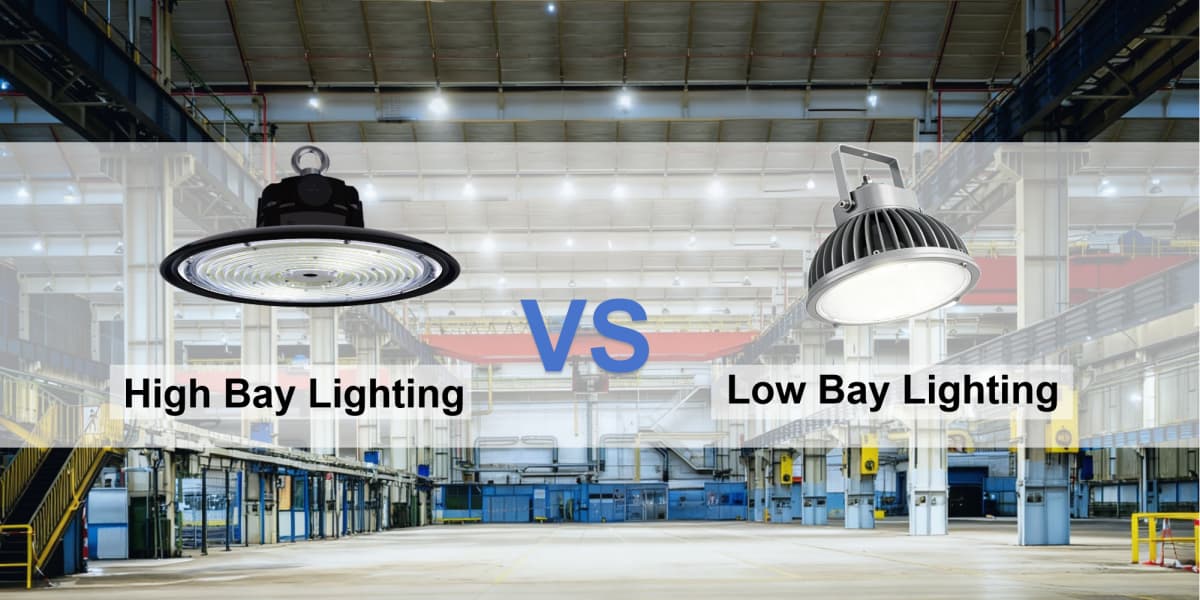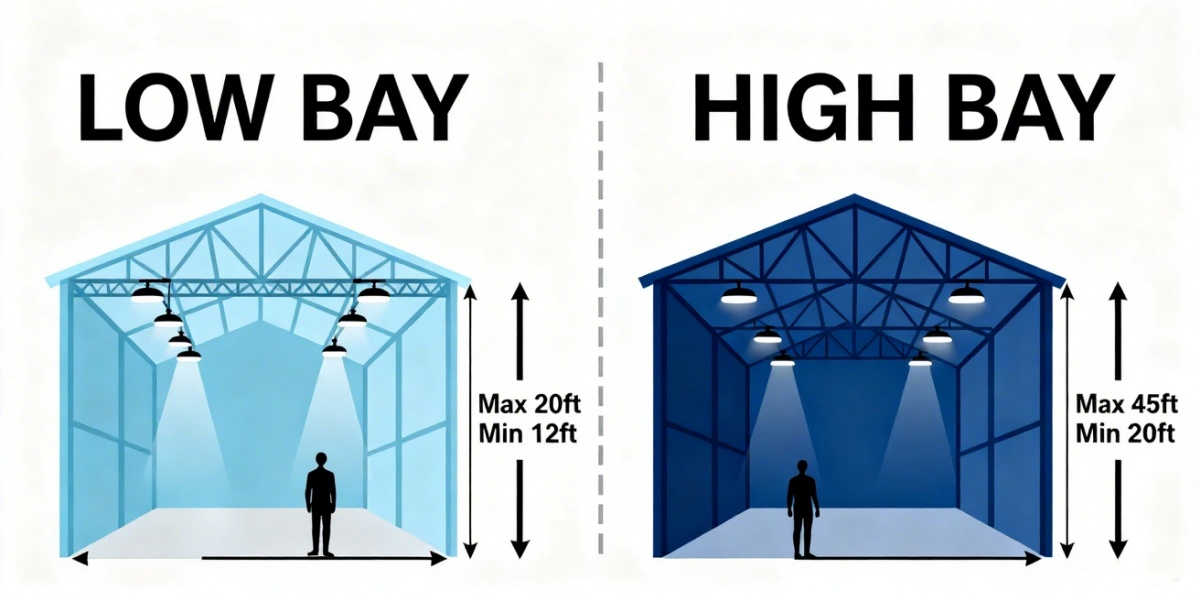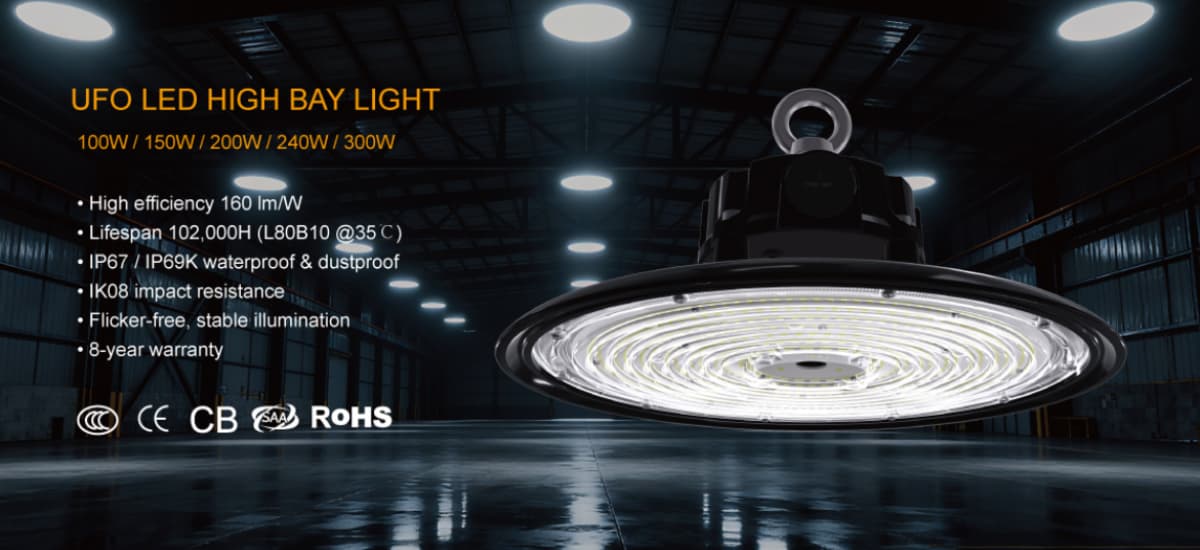高棚灯与低棚灯:真正的区别是什么?

介绍
如果你曾经抬头盯着工厂的天花板,疑惑“为什么上面有这么多种类的灯?”,你并不孤单。高棚灯和低棚灯 之争 一直困扰着不少仓库经理和承包商。
你可以这样理解:高棚灯就像工业界的强力泛光灯——设计用于照亮高耸的屋顶。而低棚灯则是它们的“接地气”版本,非常适合不需要高空照明的空间。
在本指南中,我们将详细介绍这两种照明类型的区别、各自最适合的场合,以及现代 LED 技术如何彻底改变游戏规则。
目录
什么是海湾照明?
工位照明是指专为大型开放式室内空间设计的照明系统,例如工厂、仓库、体育馆和大型零售商店。这些区域需要明亮均匀的照明,以便工人能够看得清楚、安全行动并保持生产效率。
简单来说,根据天花板高度,工位照明分为两种类型:
高棚照明——用于天花板高度超过约 20 英尺的情况。
低棚照明——用于低于约 20 英尺的天花板。
这种差异很重要,因为天花板越高,光束就必须越强越窄,才能将足够的光线照射到地板上。
过去,许多设施都使用金属卤化物灯或荧光灯具。
如今,LED工位照明 凭借其节能高效、使用寿命长、亮度稳定等优点,已成为行业标准。它能为任何工业或商业场所提供可靠且低维护成本的照明。
高棚灯和低棚灯有什么区别?
在设计工业或商业照明方案时,了解高棚灯和低棚灯的区别 至关重要。两者都适用于大面积空间,但它们的安装和性能会因天花板高度、亮度需求和光束分布而有所不同。
(1)安装高度
首要因素也是最重要的因素是天花板高度。
高棚灯 适用于 6 米(20 英尺)以上的吊顶。它们能提供强劲而集中的光线,照射到地面时亮度也不会降低。
Low bay lights work best for ceilings below 20 feet. They spread light more widely to avoid over-bright spots or glare.
Choosing the wrong type can cause wasted energy or uneven lighting.

(2) Application
High bay lighting is commonly used in warehouses, production halls, aircraft hangars, and sports arenas — any area with tall ceilings and large vertical space.
Low bay lighting fits workshops, retail stores, garages, and assembly rooms, where ceilings are lower and workers need softer, wider illumination.
The right match improves both safety and visibility in daily operations.
(3) Beam Angle
Beam design also separates the two types.
High bay fixtures use narrower beams (60°–90°) to push light farther down.
Low bay fixtures have wider beams (100°–120°) to spread light evenly at lower heights.
This ensures consistent brightness across the workspace.
(4) Mounting
High bay lights are typically hung by chains, hooks, or pendants, while low bay lights are often surface-mounted or suspended at shorter distances. The mounting method helps control light spread and maintenance access.
(5) Wattage & Lumen Output
The performance difference is clear in numbers:
High bay: 150–400W, producing about 15,000–40,000 lumens.
Low bay: 60–150W, producing about 6,000–15,000 lumens.
In summary: high bay lighting focuses light from greater heights; low bay lighting spreads it closer to the ground. Knowing this distinction ensures you select the right fixture for optimal efficiency and comfort in your facility.
LED vs Fluorescent Bay Lighting: Which Performs Better?
When comparing LED bay lights vs fluorescent, the difference in performance and long-term value is clear. LEDs have quickly become the preferred choice for factories, warehouses, and workshops across Europe and the US.
Energy Efficiency
LED bay lights use up to 70% less energy than fluorescent fixtures while producing the same or higher brightness. This means lower electricity bills and smaller carbon footprints — both major advantages for modern industrial facilities.
Brightness & Quality
LEDs provide consistent, flicker-free light with better color rendering. Workers can see details and colors more accurately, improving safety and productivity. Fluorescent lights, in contrast, tend to flicker, fade, and lose brightness over time.
Maintenance & Lifespan
A quality LED bay fixture can last 50,000 hours or more, often five times longer than fluorescent tubes. There are no ballasts to replace and no fragile glass to handle.
Instant-On & Control
LEDs turn on instantly and integrate easily with motion sensors or smart controls, something fluorescent lights can’t do effectively.
For these reasons, LEDs dominate industrial retrofits — offering stronger light, lower costs, and less downtime for maintenance.
High Bay LED Lights vs Low Bay LED Lights
When both lighting types move into the LED era, the difference between high bay LED lights vs low bay LED lights becomes more about engineering design than basic height or brightness.
Optical Design
LED technology allows light to be shaped with precision lenses rather than old-style reflectors.
High bay LEDs use narrow, high-intensity lenses to push light down from 20–50 feet, ensuring uniform brightness across tall spaces.
Low bay LEDs use wider beam optics to cover shorter distances with softer, more comfortable light.
This optical control reduces glare and improves energy efficiency per lumen.
Heat Dissipation
Because high bay fixtures run at higher wattages, they require larger aluminum heat sinks or active cooling designs to protect LED chips. Low bay units generate less heat, so they often feature compact passive cooling that keeps fixtures lighter and easier to mount.
Smart Controls & Integration
Modern industrial LED lighting supports motion sensors, daylight harvesting, and IoT control systems. High bay models often use networked or wireless systems for energy savings in warehouses, while low bay lights integrate simple occupancy sensors for smaller areas.
Efficiency & Reliability
Both types now exceed 150 lumens per watt, offering powerful, consistent light with minimal maintenance.
Ceramiclite provides high bay LED lighting solutions designed for industrial environments — combining optical precision, durable materials, and smart control compatibility to meet diverse facility needs.
Which Should You Choose — High Bay or Low Bay?
Now that we've outlined the key differences, you're probably wondering: "So which one is right for MY space?" The right choice boils down to your ceiling height, lighting needs, and work environment.
Instead of getting lost in the details, use the quick-reference guide below to make an initial determination.
The right choice depends on your ceiling height, lighting needs, and work environment. Each type serves a specific purpose, and picking the right one ensures both efficiency and comfort.
Here’s a quick guide to help you decide:
Condition | Recommended Lighting | Reason |
Ceiling above 20 ft (6 m) | High Bay | Delivers concentrated brightness with a narrow beam angle to reach the floor evenly. |
Ceiling below 20 ft | Low Bay | Offers a wider beam for softer, more diffused light. |
Warehouses / factories / gymnasiums | High Bay | Designed for high illumination intensity and large spaces. |
Retail stores / garages / workshops | Low Bay | Provides balanced brightness and better visual comfort for smaller areas. |
Tip: When in doubt, choose based on your lux requirement — high bay for power, low bay for comfort.
For a more detailed analysis of each factor—like calculating exact brightness needs or selecting the perfect beam angle—continue to the next section, where we break down the complete selection process.
How to Choose the Right Bay Lighting for Your Facility?
Selecting the right fixture can make or break your lighting performance. When you choose the right bay lighting, the goal is simple — achieve consistent brightness, reduce energy costs, and maintain long-term reliability. Here’s a quick guide to help you decide.
(1) Beam Angle and Width
Start with your ceiling height.
For ceilings above 20 ft, use narrower beams (60°–90°) to concentrate light on the work floor.
For ceilings below 20 ft, choose wider beams (100°–120°) for smoother, more even coverage.
This ensures your light reaches the right area without glare or dark spots.
(2) Mounting & Distribution
Consider your mounting options: chain, pendant, or surface mount.
High bay fixtures are often suspended to control light spread.
Low bay fixtures can be surface-mounted for a cleaner look.
Proper mounting height directly affects light distribution and maintenance access.
(3) Retrofitting Existing Fixtures
If your facility already uses older metal halide or fluorescent lights, LED retrofits are the fastest way to cut energy use and improve brightness. They fit existing mounts, minimizing installation cost and downtime.
(4) Power & Brightness
Use lumens per square foot as your guide:
Storage areas: 10–20 lm/ft²
Assembly or production: 30–50 lm/ft²
Inspection zones: 70+ lm/ft²
Focus on lumen output, not just wattage, to ensure efficient lighting design.
(5) Color Temperature
A neutral white tone between 4000K and 5000K gives the best visibility for industrial work. It reduces eye strain and enhances material contrast.
(6) Shape: UFO vs Linear Fixtures
UFO high bay lights deliver strong, centralized illumination — ideal for large, open areas.
Linear low bay lights spread light evenly across aisles or production lines, perfect for lower ceilings and rectangular layouts.
Visualizing this helps match fixture shape with your room geometry.
(7) Energy Usage & ROI
Calculate your return on investment (ROI) based on energy savings, lifespan, and reduced maintenance. Most LED systems pay for themselves within 1–2 years, then continue saving for over a decade.
By following these steps, facility managers and engineers can confidently select lighting that improves safety, productivity, and energy efficiency — all while ensuring the best long-term value for their operation.
Why LED Bay Lights Are the Future of Industrial Lighting?
The shift toward LED bay lights is more than a trend — it’s the future of industrial lighting. Across Europe and the US, factories and warehouses are moving away from traditional fixtures to smarter, more efficient LED systems that support long-term sustainability goals.
Modern LED bay lights do more than just illuminate. They connect. Integrated motion sensors, daylight harvesting, and IoT controls allow lights to adjust automatically based on occupancy or ambient light levels. This reduces wasted energy and extends fixture lifespan while keeping workspaces consistently bright and safe.
Governments and corporations are also driving change. Energy-efficiency standards and ESG requirements now encourage facilities to cut power use and carbon emissions. LEDs make compliance simple — delivering high output with low consumption.
Looking ahead, LED lighting will become the backbone of smart, data-driven facilities, where lighting systems communicate with HVAC, security, and production networks.
Ceramiclite’s HB01 High Bay LED bay lights are engineered with these innovations in mind — combining optical precision, smart compatibility, and industrial-grade durability. They’re ready for today’s efficiency demands and tomorrow’s intelligent infrastructure.
Want to know more about What is New in Industrial LED Lighting?
Conclusion
Choosing between high bay vs low bay lighting comes down to three key factors — ceiling height, beam angle, and brightness needs. High bay lights deliver powerful, focused illumination for tall spaces, while low bay lights provide softer, wider coverage for lower ceilings.
Upgrading to LED bay lighting ensures higher efficiency, lower maintenance, and long-term ROI — a smart move for any modern facility.
仍然不确定哪种方案适合您的空间?立即从 Ceramiclite 获取免费照明布局方案 ,探索适合您工业环境的性能、节能和可靠性的完美平衡。
_thumb.jpg)

